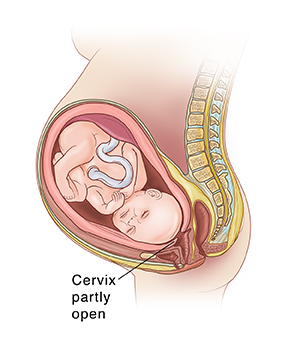Labor and Childbirth: Active Labor
During active labor, your contractions will be stronger and more rhythmic than with early labor. They peak and subside like waves. They may happen 2 to 3 minutes apart and last about 45 to 60 seconds. This part of labor can be hard work. But it is often shorter than early labor. When you reach active labor, exams and tests will be done to see how you and your baby are doing.
 |
| During labor, the cervix begins to efface (thin) and dilate (open). |
Evaluating you and your baby
An exam tells how you and your baby are responding to contractions. Your blood pressure, temperature, and pulse will be checked. A blood or urine sample may also be taken. A fetal monitor will be used to check your baby’s heart rate. Sometimes an IV (intravenous) line is started to give you medicine and fluids.
Moving ahead with labor
You may now feel contractions in your whole stomach instead of just the lower part (like during early labor). If your amniotic sac has not broken already, it may break now. Or it may be broken for you. To help your baby descend, change position often. Walking or sitting in a rocking chair or recliner may help. You may find it hard to relax even though you are tired. You may also be less interested in talking than you were earlier. If you’re having anesthesia, you may want to get it now.
Special issues during labor
If labor doesn’t progress well or a problem arises, you may need a cesarean. But your healthcare providers may take certain steps to help you prevent a cesarean:
-
If your cervix isn’t dilating, a medicine (oxytocin) may be used to augment labor.
-
If fetal monitoring shows your baby isn’t getting enough oxygen, shifting your body position may help. You may also be given oxygen through a mask.
-
If you have preeclampsia (a condition that results in high blood pressure, swelling, and other symptoms), you may be given medicines by IV (intravenous). Your healthcare provider may also tell you to lie on your left side.
Responding to contractions
During contractions, try to stay relaxed. Tense muscles use more oxygen, eat up your body’s energy, and increase pain. Use the breathing and relaxation methods you may have learned. And let your support person know how they can help. If you’ve had problems during a previous birth, focus on the present. Keep in mind that no 2 births are the same.
Support person’s note
Here's how you can help:
-
Have the mother walk or change positions at least once an hour. This improves circulation and helps the baby descend.
-
Keep reminding the mother to breathe and relax through each contraction.
-
Reassure them. Try to keep them from getting anxious or overstressed.
-
Take care of yourself. Take a short break to eat or go to the bathroom when you need to.
-
Rest when the mother does. You’ll both benefit.